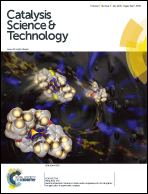Inhibitory effect of SO2 on side reactions of NH3-SCR over olivine†
Abstract
Olivine catalysts prepared by calcination achieved high N2 selectivity and good NH3-SCR activity at 150–450 °C. The existence of SO2 significantly inhibited the formation of NO and N2O in the NH3-SCR reaction at the temperature range of 325–450 °C. This is mainly because of the reductive properties of SO2 that could restrain the over-oxidization of NH3. Therefore, both the NOx conversion and N2 selectivity were improved at high temperatures. Accordingly, the presence of SO2 shifted the optimal temperature window of the olivine catalyst by about 75 °C towards high temperature. Both the Langmuir–Hinshelwood mechanism and the Eley–Rideal mechanism contributed to the SCR reaction over the olivine catalyst. Temperature-programmed desorption experiments show that excess ammonium sulfate formed in the presence of SO2 suppressed the reaction of adsorbed NOx species with adsorbed NH3 species at low temperatures. Lots of activated NH3 species (−NH2) were formed by the decomposition of ammonium sulfate at high temperatures, promoting the reaction of adsorbed NH3 species (−NH2) with both adsorbed NOx and gaseous NOx. Preliminary results suggest that olivine is a potential catalyst for treating sulfur-containing exhausts.


 Please wait while we load your content...
Please wait while we load your content...